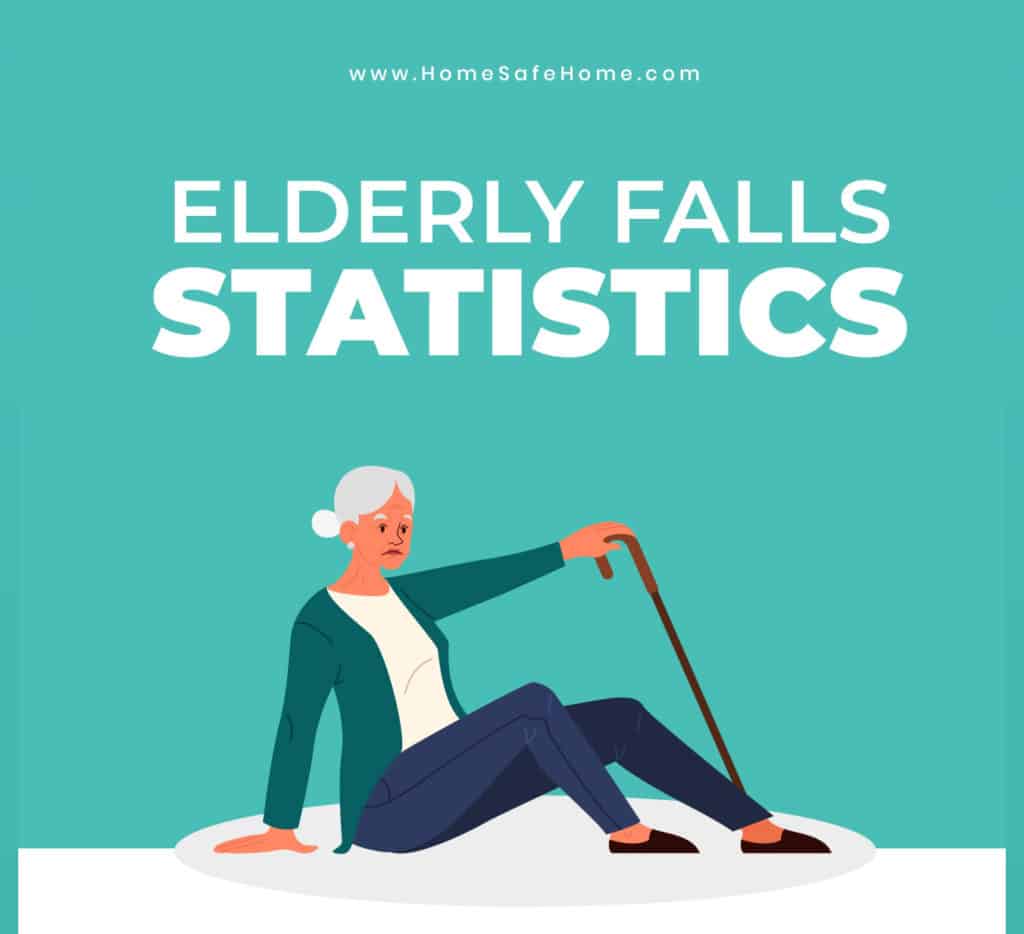Unfortunately, falls in the elderly are quite common. Many people, especially the younger relatives of the elderly, may not realize how difficult falls can be until their family member is affected.
Not only can you or your loved one end up with serious injuries, but the costs involved could be severe. It’s essential to know the statistics and what you can do to prevent a fall from taking place.
Here you can look into the typical ages of older people who fall, the possible injuries that someone may sustain, costs after a fall, and several other vital elderly falls statistics.
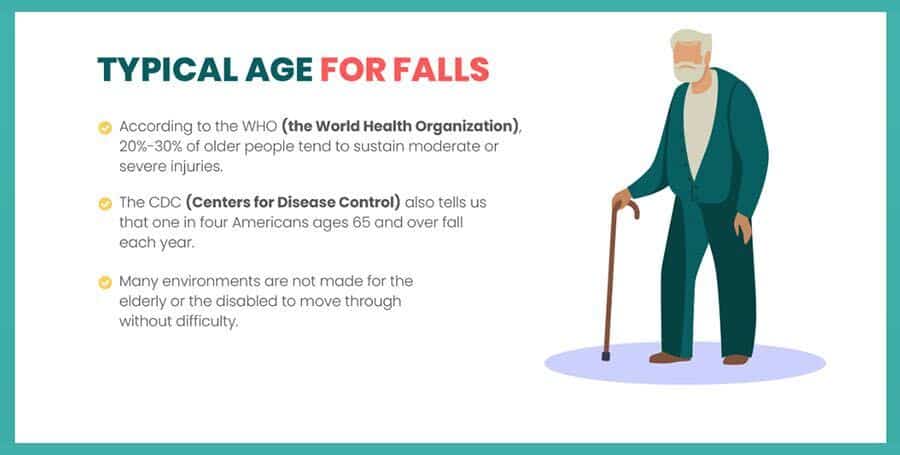
Typical Age for Falls
Older people are the most at risk for severe injury or even death after falling. The older the person, the higher the risk. According to the WHO (the World Health Organization), 20%-30% of older people tend to sustain moderate or severe injuries, including hip fractures, bruising, or head trauma.
When aging, your body goes through several changes, particularly cognitive and sensory changes that make it more challenging to keep your balance or better respond physically to a fall.
Something else to consider is that many environments are not made for the elderly or the disabled to move through without difficulty.
The CDC (Centers for Disease Control) also tells us that one in four Americans ages 65 and over fall each year, and falls are the leading cause of fatal injury and trauma-related admissions to hospitals for that age group.

Gender and Falls
Falls are a risk for both men and women, but the particular risks in gender statistics often depend on the region or the country. However, while both genders are at risk, some data shows that women fall more often, but fewer women suffer fatal falls than men.
Men face fatal falls throughout the world, perhaps due to a tendency toward risk-taking behavior or more hazardous jobs. Women are potentially more prone to falls and tend to sustain severe injuries from them. The CDC claims that women account for three-quarters of all hip fractures.
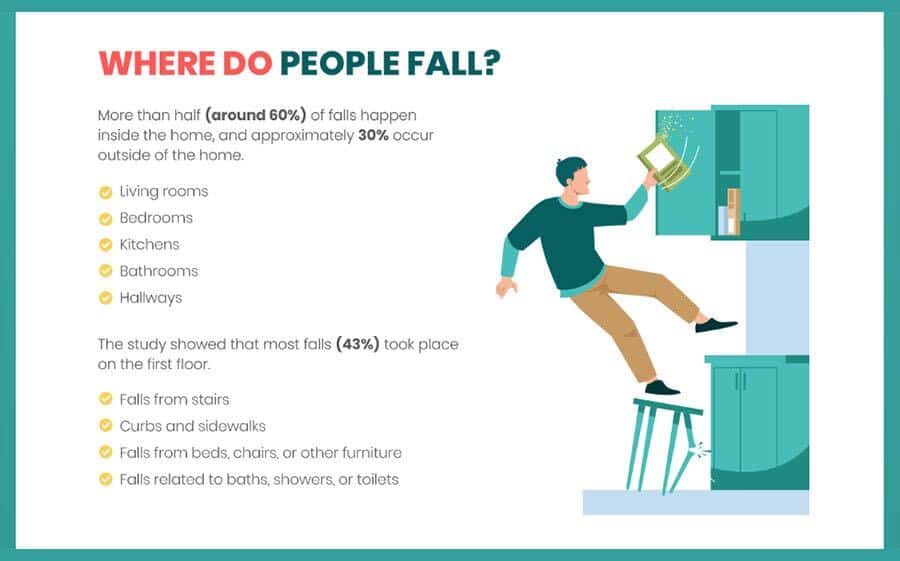
Where Do People Fall?
Additional information about falls that you might not see in medical organizations’ statistics include where people fall and how falls may happen.
There are common locations where the elderly may take falls. More than half (around 60%) of falls happen inside the home, and approximately 30% occur outside of the home, typically in an everyday setting such as walking outdoors, running errands, etc. Roughly 10% happen within hospitals, clinics, and other medical or nursing facilities.
Statistics from the National Health Interview Survey gave room-specific and environmental details about falls. For homes with no stairs, the rooms in which falls took places, from highest to lowest percent, were:
- Living rooms
- Bedrooms
- Kitchens
- Bathrooms
- Hallways
For houses with stairs, falls from furniture, and so on, the study showed that most falls (43%) took place on the first floor. The rest in descending order included:
- Falls from stairs
- Curbs and sidewalks
- Falls from beds, chairs, or other furniture
- Falls related to baths, showers, or toilets
There was also a category for unspecified falls, coming to 26% of the study reports.
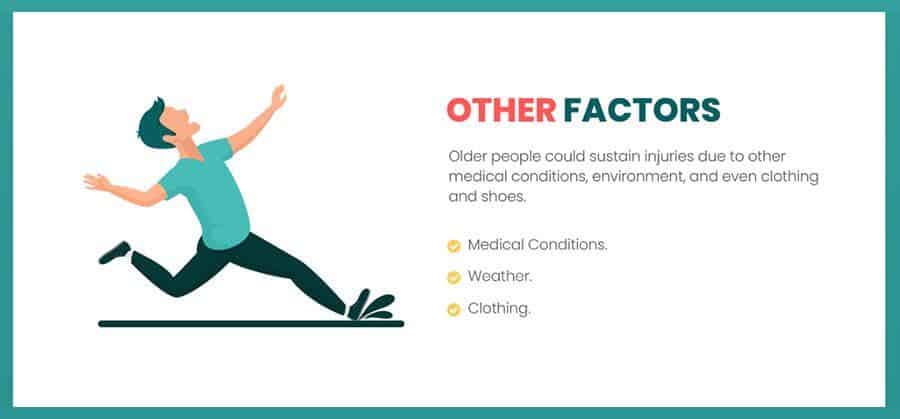
Other Factors
There are also other factors aside from location that can affect how falls happen. Several things can lead to a fall in addition to someone’s location within the home or outside it. Older people could sustain injuries due to other medical conditions, environment, and even clothing and shoes.
There may be several ordinary things that could turn out to be falling hazards. Things like too much clutter or too many obstacles in your way like furniture could result in a fall even if you do not have an existing medical condition that makes you predisposed to falling.
Medical Conditions
It’s a good idea for those with pre-existing medical conditions to ensure that they find out from their doctor if what they have leads to them being a fall risk.
If you have changed your medication or are experiencing side effects (drowsiness, lightheadedness, etc.) from others, you could be more at risk.
Weather
Drastic weather changes can lead to changes in your home, as well. Damage to your floors or roof from leaks can cause slips and falls. Similarly, if a room has too much light or an older adult is out in the sunlight for too long, it could make them dizzy or lightheaded. When this happens, it is easier to trip over something in the home or outside.
Clothing
In addition to the environment and medical conditions, something as simple as clothing and shoes might seem like a less obvious factor. For example, tighter clothing is a problem for the elderly in that it could potentially restrict the flow of blood that affects motor skills.
On the other hand, clothing that is too large gets caught on several things around your home, such as doors and furniture. High fall risk seniors should avoid slippery-soled shoes, loose-fitting shoes that could easily slip off while walking, and shoes like flip-flops and high heels, making balancing difficult.
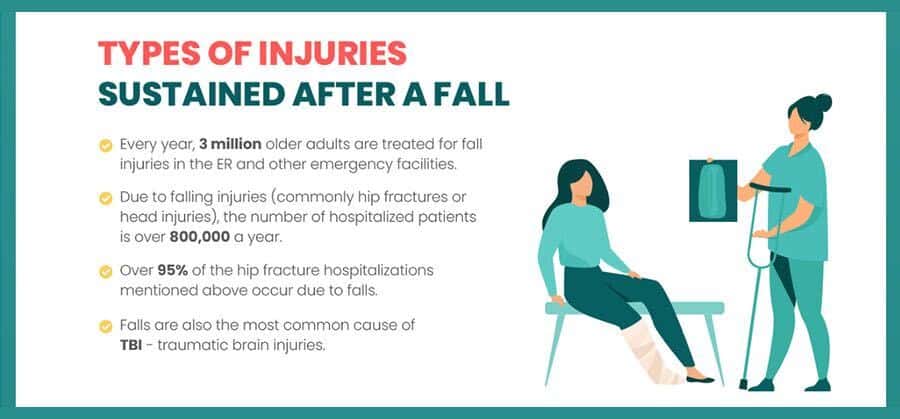
Types of Injuries Sustained After a Fall
According to the CDC, not all falls result in injuries, but one out of five falls leads to severe injuries. These severe injuries include head wounds and broken bones.
The injuries involving broken bones typically include fractures in the arms, wrists, hips, and ankles. Head injuries are quite severe, and anyone who has hit their head during a fall should see the doctor as soon as possible.
These types of falls are quite dangerous for people taking blood-thinning medication. It is essential to check that the one has sustained no brain injuries during the fall.
A fear of falling may develop in people who have fallen and not suffered any injuries. The fear of continuing with regular activities makes the person less active and increases their risk of falling due to their bodies becoming weaker.
More statistics on falling and injuries include:
- Every year, 3 million older adults are treated for fall injuries in the ER and other emergency facilities.
- Due to falling injuries (commonly hip fractures or head injuries), the number of hospitalized patients is over 800,000 a year.
- Over 95% of the hip fracture hospitalizations mentioned above occur due to falls.
- Falls are also the most common cause of TBI – traumatic brain injuries.
Cost of Falls
The high financial costs for falls and injuries sustained from them can be stressful. According to WHO, the cost per injury totaled roughly $1,049 in the United States healthcare system for adults aged 65 and over.
Additionally, the CDC’s records indicated in 2015, medical costs for falls were over $50 billion, and Medicare and Medicaid were the programs that took on 75% of those costs. Meanwhile, non-fatal falls cost a total of $754 million.
Prevention is now becoming financially necessary as the population grows older. The covered costs came to about 6% of Medicare and 8% of Medicaid’s overall expenses.
Nearly 99% of the $50 billion went toward non-fatal falls, though studies remain uncertain about that percentage’s exact cost. There were disputes over outpatient costs and what directly went to these falls.
These studies also found that people 85 years or older are at the highest risk, which is also increasing. They predict that because this group continues to grow, costs from falls will likely increase over the years.
They also mentioned that public health insurance programs already face financial difficulty, yet they finance 75% of falls in the elderly.
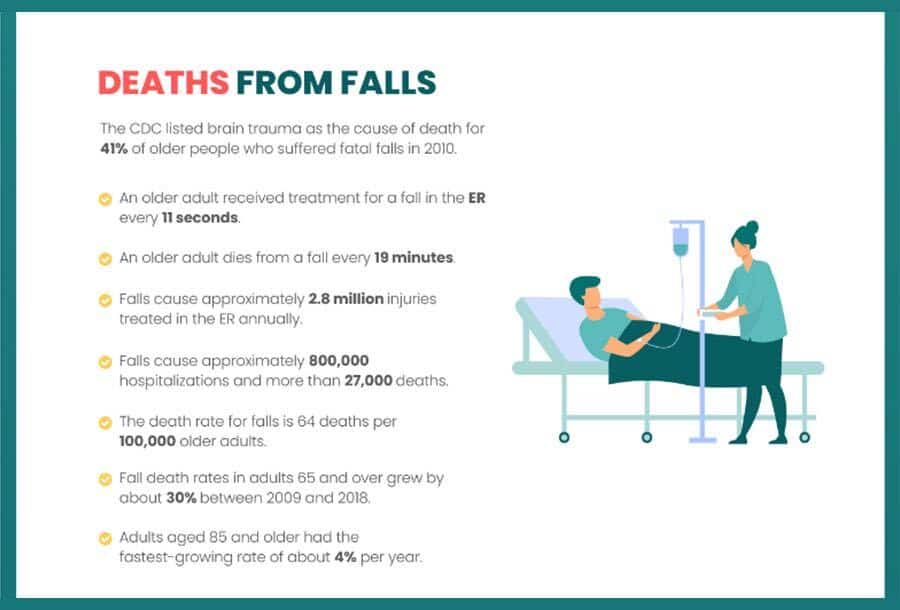
Deaths from Falls
Those concerned about elderly family members need to remember that falls are the leading cause of fatal injuries for the elderly in the United States.
Older adults are at more of a risk due to fragile bones and skin that could break, tear, and bruise more easily than younger people.
Balance and agility are also not what they used to be in the elderly, meaning that slow reflexes become a problem, and catching yourself before a fall turns into a more difficult task.
The CDC listed brain trauma as the cause of death for 41% of older people who suffered fatal falls in 2010. However, other injuries can still be life-threatening in cases where someone needs surgery for a broken bone. Surgeries like this leave them vulnerable to possible infection.
Other important statistics include:
- An older adult received treatment for a fall in the ER every 11 seconds.
- An older adult dies from a fall every 19 minutes.
- Falls cause approximately 2.8 million injuries treated in the ER annually.
- Falls cause approximately 800,000 hospitalizations and more than 27,000 deaths.
- The death rate for falls is 64 deaths per 100,000 older adults.
- Fall death rates in adults 65 and over grew by about 30% between 2009 and 2018.
- Adults aged 85 and older had the fastest-growing rate of about 4% per year.
- Adults aged 85 and older had the fastest-growing rate of about 4% per year.
The best way to avoid a fall is by learning and remembering the right strategies. When doing your research regarding falls, you can take a few steps for preventative measures.
Creating a safe environment is one of, if not the first thing to do. You will also want to take what you have learned to suggest changes in clothing, as well as educating yourself on medical conditions and medication.
There are also fall prevention programs available to help you identify existing risks and correct them. These programs aim to reduce the number of people that fall, particularly the elderly.
Fall prevention programs can provide a lot of helpful things, such as:
- Home assessment and environment adjustments for anyone who is a high risk or has a history of falling
- Screening the home and living environments for risks.
- Physical activity programs like Tai Chi, balance, and strength exercises with a community of people in the same boat.
- Training to keep your balance and muscle-strengthening as advised by a trained professional.
- Clinical check-ups find medical risk factors like modifying prescribed medicine, blood pressure treatment, calcium supplements, or other necessary treatments.
- Prescribing the best mobility aids or devices that help with physical or cognitive impairment assistive devices to address physical and sensory impairments.
Even when learning about prevention, removing possible risks that might lead to a fall, anything can happen. It helps to prepare yourself by remembering specific steps if you or a loved one should fall.
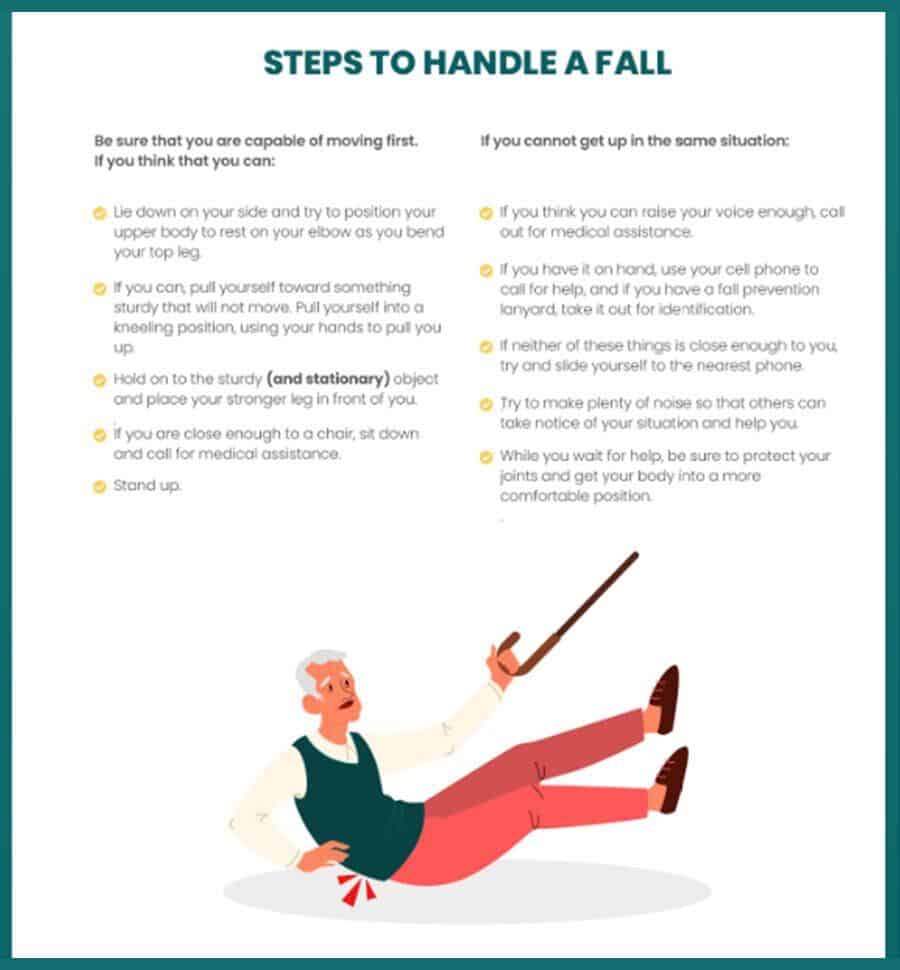
Steps to Handle a Fall
What is essential in all emergencies is to stay calm. If you are the one who has fallen, assess how your body feels. Do not move during this first part of the process. Be sure that you are capable of moving first. If you think that you can:
- Lie down on your side and try to position your upper body to rest on your elbow as you bend your top leg.
- If you can, pull yourself toward something sturdy that will not move. Pull yourself into a kneeling position, using your hands to pull you up.
- Hold on to the sturdy (and stationary) object and place your stronger leg in front of you.
- Stand up.
- If you are close enough to a chair, sit down and call for medical assistance.
If you cannot get up in the same situation:
- If you think you can raise your voice enough, call out for medical assistance.
- If you have it on hand, use your cell phone to call for help, and if you have a fall prevention lanyard, take it out for identification.
- If neither of these things is close enough to you, try and slide yourself to the nearest phone.
- Try to make plenty of noise so that others can take notice of your situation and help you.
- While you wait for help, be sure to protect your joints and get your body into a more comfortable position.
Final Thoughts
There are serious risks involved in falls, and it is better to know what conditions to look out for, whether it be for yourself or your loved ones. Knowing how to prevent falls and how to deal with them is equally vital for everyone.

